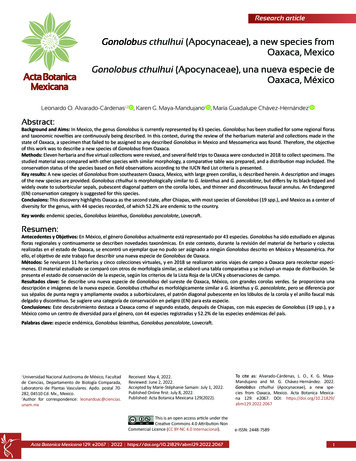
Transcription
Research articleGonolobus cthulhui (Apocynaceae), a new species fromOaxaca, MexicoGonolobus cthulhui (Apocynaceae), una nueva especie deOaxaca, MéxicoLeonardo O. Alvarado-Cárdenas1,2 , Karen G. Maya-Mandujano1 , María Guadalupe Chávez-Hernández1Abstract:Background and Aims: In Mexico, the genus Gonolobus is currently represented by 43 species. Gonolobus has been studied for some regional florasand taxonomic novelties are continuously being described. In this context, during the review of the herbarium material and collections made in thestate of Oaxaca, a specimen that failed to be assigned to any described Gonolobus in Mexico and Mesoamerica was found. Therefore, the objectiveof this work was to describe a new species of Gonolobus from Oaxaca.Methods: Eleven herbaria and five virtual collections were revised, and several field trips to Oaxaca were conducted in 2018 to collect specimens. Thestudied material was compared with other species with similar morphology, a comparative table was prepared, and a distribution map included. Theconservation status of the species based on field observations according to the IUCN Red List criteria is presented.Key results: A new species of Gonolobus from southeastern Oaxaca, Mexico, with large green corollas, is described herein. A description and imagesof the new species are provided. Gonolobus cthulhui is morphologically similar to G. leianthus and G. pancololote, but differs by its black-tipped andwidely ovate to suborbicular sepals, pubescent diagonal pattern on the corolla lobes, and thinner and discontinuous faucal annulus. An Endangered(EN) conservation category is suggested for this species.Conclusions: This discovery highlights Oaxaca as the second state, after Chiapas, with most species of Gonolobus (19 spp.), and Mexico as a center ofdiversity for the genus, with 44 species recorded, of which 52.2% are endemic to the country.Key words: endemic species, Gonolobus leianthus, Gonolobus pancololote, Lovecraft.Resumen:Antecedentes y Objetivos: En México, el género Gonolobus actualmente está representado por 43 especies. Gonolobus ha sido estudiado en algunasfloras regionales y continuamente se describen novedades taxonómicas. En este contexto, durante la revisión del material de herbario y colectasrealizadas en el estado de Oaxaca, se encontró un ejemplar que no pudo ser asignado a ningún Gonolobus descrito en México y Mesoamérica. Porello, el objetivo de este trabajo fue describir una nueva especie de Gonolobus de Oaxaca.Métodos: Se revisaron 11 herbarios y cinco colecciones virtuales, y en 2018 se realizaron varios viajes de campo a Oaxaca para recolectar especímenes. El material estudiado se comparó con otros de morfología similar, se elaboró una tabla comparativa y se incluyó un mapa de distribución. Sepresenta el estado de conservación de la especie, según los criterios de la Lista Roja de la UICN y observaciones de campo.Resultados clave: Se describe una nueva especie de Gonolobus del sureste de Oaxaca, México, con grandes corolas verdes. Se proporciona unadescripción e imágenes de la nueva especie. Gonolobus cthulhui es morfológicamente similar a G. leianthus y G. pancololote, pero se diferencia porsus sépalos de punta negra y ampliamente ovados a suborbiculares, el patrón diagonal pubescente en los lóbulos de la corola y el anillo faucal másdelgado y discontinuo. Se sugiere una categoría de conservación en peligro (EN) para esta especie.Conclusiones: Este descubrimiento destaca a Oaxaca como el segundo estado, después de Chiapas, con más especies de Gonolobus (19 spp.), y aMéxico como un centro de diversidad para el género, con 44 especies registradas y 52.2% de las especies endémicas del país.Palabras clave: especie endémica, Gonolobus leianthus, Gonolobus pancololote, Lovecraft.Universidad Nacional Autónoma de México, Facultadde Ciencias, Departamento de Biología Comparada,Laboratorio de Plantas Vasculares. Apdo. postal 70282, 04510 Cd. Mx., Mexico.2Author for correspondence: leonardoac@ciencias.unam.mx1Received: May 4, 2022.Reviewed: June 2, 2022.Accepted by Marie-Stéphanie Samain: July 1, 2022.Published Online first: July 8, 2022.Published: Acta Botanica Mexicana 129(2022).This is an open access article under theCreative Commons 4.0 Attribution-NonCommercial Licence (CC BY-NC 4.0 24 2021 exicanae2067 2022 https://doi.org/10.21829/abm129.2022.2067To cite as: Alvarado-Cárdenas, L. O., K. G. MayaMandujano and M. G. Chávez-Hernández. 2022.Gonolobus cthulhui (Apocynaceae), a new species from Oaxaca, Mexico. Acta Botanica Mexicana 129: e2067. DOI: https://doi.org/10.21829/abm129.2022.2067e-ISSN: 2448-75891
Alvarado-Cárdenas et al.: Gonolobus cthulhui, a new species from MexicoIntroductionGonolobus Michx. (Apocynaceae, subfamily Asclepiadoideae,subtribe Gonolobinae) comprises ca. 150 species in theAmericas (Rosatti, 1989; Stevens, 2001a, 2009; Krings andXiang, 2004; Krings, 2008; McDonnell et al., 2018) and itis the most species-rich genus in the subtribe, followed byMatelea Aubl. (sensu Endress et al., 2018) with approximately 75 species. The members of Gonolobus are climbing herbs or vines, with a corolla that often has a faucalring (corolline corona) surrounding the gynostegial corona,which is adnate to the base of the gynostegium and thecorolla; one distinctive attribute is the dorsal and fleshy appendix of the anther (Stevens, 2009; Morillo, 2015).Krings et al. (2008) noted that Gonolobus s.s. hasa substitution of thymine by guanine at the position 279of the trnL-F intergenic spacer, which is considered amolecular synapomorphy in that locus. In the last two decades, Gonolobus has been revised in some treatments ofthe Americas, such as Brazil (BFG, 2020), Lesser Antilles(Krings, 2007), Nicaragua (Stevens, 2001b), southeasternUnited States of America (Krings and Xiang, 2004), WestIndies (Krings, 2008), but it requires further evaluations toclarify its systematics.Gonolobus is currently represented by 43 species inMexico, growing mainly in deciduous and tropical foreststhat characterize the Pacific and Atlantic states of the country (Alvarado-Cárdenas et al., 2020a, b; 2021a). There areno reports that the plants are cultivated as ornamental, butsome produce edible fruits (Mapes and Basurto, 2016; Alvarado-Cárdenas et al., 2020b). The genus has been studied in some regional floras (e.g., Juárez-Jaimes and Lozada-Pérez, 2003; Stevens, 2001a, 2009; Cortez, 2018), andtaxonomic novelties are being continuously described (Stevens and Montiel, 2004; Stevens, 2005; Juárez-Jaimes etal., 2009; Alvarado-Cárdenas et al., 2020b; 2021a).Along with the review of the herbarium material andcollections made in the state of Oaxaca, a specimen thatcould not be assigned to any described Gonolobus in Mexico and Mesoamerica was found, even though this materialshowed morphological similarity with G. pancololote (Sessé& Moc.) L.O. Alvarado ( G. megalocarpus P.G. Wilson) (Alvarado-Cárdenas et al., 2021b) and G. leianthus Donn. Sm.due to their similar-sized, green flowers. Therefore, theobjective of this work was to describe a new species. It isdescribed here and images and a distribution map are provided, as well as comparative table with morphologicallysimilar species.Material and MethodsThe herbarium specimens were studied in the herbariaENCB, FCME, FEZA, HGOM, HUAP, IBUG, IEB, MEXU, OAX,SERO, and UAMIZ (Thiers, 2021), as well as virtual collections from the George B. Hinton Herbarium (JSTOR, 2021),Royal Botanic Gardens (K, 2021), NY (NY, 2021), TROPICOS(TROPICOS, 2021), and Herbaria of the University of California (UC, 2021). Leaf terminology is based on Hickey (1973),the indumentum descriptions on Harris and Harris (1994),and the corona terminology on Liede and Kunze (1993) andKunze (1995). The distribution map was prepared with herbarium records, mapped using QGIS v. 3.26 (QGIS, 2020).When georeferencing was needed, Google Earth (2022)was used.The authors conducted several field trips in Oaxacastate in 2018 to collect specimens of the species describedherein. The collections were deposited in the herbaria FCMEof the Facultad de Ciencias, Universidad Nacional Autónomade México (UNAM) and MEXU of the Instituto de Biología,UNAM. The leaves and flowers were collected and fixed in70% alcohol solution. Then, they were dissected and measured using a stereomicroscope (Nikon C-Leds, SMZ445, Tokyo, Japan). These specimens were compared with those ofother species of Gonolobus with similar morphology.The conservation status of the new species is provided, applying the IUCN Red List criteria (IUCN, 2019).Collection points were mapped with GeoCAT (Bachman etal., 2011), with a cell width of 2 km, to assess the extentof occurrence (EOO) and the area of occupancy (AOO).The observations about the observed populations and thequality of the habitat are included.The species concept of Templeton (1989) wasfollowed, recognizing a species as “the most inclusivepopulation of individuals that have the potential forphenotypic cohesion through intrinsic cohesion mechanisms.” Although the concept is based on a framework ofpopulation genetics, it does not discard other cohesive factors to explain the recognition of the species, such as icana128:e1829 2021 exicanae2067 2022 https://doi.org/10.21829/abm129.2022.20672
Alvarado-Cárdenas et al.: Gonolobus cthulhui, a new species from Mexicogeographic distribution, phenotypic variability restrictions,and ecological restrictions that constitute the manifestation of morphological and habitat distinctiveness.ResultsTaxonomyGonolobus cthulhui L.O. Alvarado, K. Maya M. & M.G.Chávez, sp. nov. Figs. 1, 2, 3.TYPE: MEXICO. Oaxaca, San Miguel del Puerto, SantaMaría Xadani, a 100 metros del camino del Rancho Dioon,hacia finca cafetalera, sobre ladera, 15 58'59.436''N,96 05'35''W, 20.VI.2018 (fl.), K. Maya et al. 46 (holotype:FCME!, isotype: MEXU!).Gonolobus cthulhui is morphologically similar to G.leianthus and G. pancololote because of their similar sizeand green corollas and white margined corolla lobes. Thenew species differs from these taxa by its black-tipped andwidely ovate to suborbicular sepals, its pubescent diagonalpattern on the corolla lobes, and thinner and discontinuousfaucal annulus.Herbaceous perennial vines; latex white; stems withmixed pubescence, glandular capitate trichomes present,ca. 0.05 mm long, spreading, eglandular trichomes, hirsute,0.5-1 mm long, in two lines along the internodes, but mostdense at the nodes; leaf blades ovate to oblong-ovate, 9.212.3(-15.3) 4.3 5-6.7(-11) cm, base cordate, lobes 1.42.1(-2.9) long, apex acute to rounded, abruptly acuminate,acumen narrowly obtuse, 6-9 mm long, adaxial surfacewith glandular capitate trichomes at the base, eglandular trichomes scattered along the midvein, abaxial surfacepubescent, without glandular-capitate trichomes, eglandular trichomes adpressed, margins entire, colleters 4-6,0.5-0.8 mm tall; petioles 4.2-8.1(-11.5) cm long, sparselypubescent, trichomes most dense along the adaxial ridges,glandular capitate trichomes spreading, ca. 0.1 mm long,eglandular trichomes ascending (some retrorse), 0.3-0.4mm long; stipular colleters absent; inflorescences racemiform; peduncles (1.6-)2.5-4.7 cm long, indumentum as onthe petioles or more sparse; pedicels 2.1-2.8 cm long, in-dumentum as on the petioles, sometimes with scatteredlong trichomes; bracts lanceolate to elliptic-lanceolate,7-11 1.9-2.5 mm, persistent, glabrous, abaxial surfacesometimes pubescent, glandular capitate trichomes absent, eglandular trichomes antrorse, ca. 0.2 mm long;sepals 5, widely ovate to suborbicular, 8-11 6.4-7 mm,green, apices obtuse, black, margins glabrous, adaxial andabaxial surface glabrous; colleters 1-2 per sinus; corollagreen, lobes 5, narrowly ovate-lanceolate, 1.8-2 0.8-1cm, slightly overlapping at the base, adaxial surface pubescent diagonally distributed, eglandular trichomes to 0.12mm, abaxial surface glabrous, apex black, faucal annulus(corolline corona) interrupted, 5 thin ridges, 0.15-0.2 mmwide, opposite to each corolla lobe sinus, short-hispid; gynostegial corona of fused staminal and interstaminal parts,single, erect-fimbriate; anther with laminar dorsal appendage, 1.6-1.7 1.4-1.5 mm, obovate in general view, apexbilobed, erect; style-head 4.5-5 mm diameter, deeply angulate (star-shape), apex yellow, probably secretory, stipeca. 0.5 mm; pollinaria with corpuscula 0.2-0.3 mm long,pollinia borne horizontally, oblong-ovate ca. 1.1 0.4 mm;follicles ovoid, ca. 12.8 6.1 cm (immature), non-winged,glabrous; seeds not seen.Distribution and habitat: Gonolobus cthulhui is endemic to the state of Oaxaca, where it occurs in tropicalsubcaducifolious forest and perturbed areas derived thereof, growing from 300 to 580 m a.s.l. (Fig. 4).Phenology: flowering from June to August, fruitingfrom October to December (Fig. 2).Etymology: the name refers to the fictional characterof Cthulhu, a primigenial god described in Lovecraft’s shorthorror story “The Call of Cthulhu”. According to Lovecraft,the name is impossible to pronounce because it comesfrom an alien language; however, it is suggested to be pronounced “ka-thoo-loo”. The authors use the name in orderto, as Zilli et al. (2005) pointed out, highlight the unknownbeings living on our planet.Conservation status: this species is restricted toa minimal area of southeastern Oaxaca State, Mexicana128:e1829 2021 exicanae2067 2022 https://doi.org/10.21829/abm129.2022.20673
Alvarado-Cárdenas et al.: Gonolobus cthulhui, a new species from MexicoFigure 1: Gonolobus cthulhui L.O. Alvarado, K. Maya M. & M.G. Chávez. A. branch with leaves and inflorescences; B. detail of the gynostegium;C. apical view of the flower; D. adaxial view of floral bud, showing corolla bud in the center surrounded by sepals; E. basal view of the flower; F.lateral view of the flower; G. follicle (K. Maya et al. 46, FCME). Abbreviations: FA faucal annulus, P petal, Pd pedicel, SA staminal appendage,SH stylar head, S Mexicana128:e1829 2021 exicanae2067 2022 https://doi.org/10.21829/abm129.2022.20674
Alvarado-Cárdenas et al.: Gonolobus cthulhui, a new species from MexicoFigure 2: Gonolobus cthulhui L.O. Alvarado, K. Maya M. & M.G. Chávez. A. leaf and flower; B. flower; C. floral bud; D. fruit.(EOO 2383 km2, AOO 12 km2; Fig. 4). The plants have beencollected in four localities in Oaxaca and appear to toleratesome anthropogenic impact, growing on the fences of thehouses associated with subperennial forest. Local peoplecook the fruits to prepare a soup, and this activity couldaffect the future of the population dynamics of the species.The information about the distribution, abundance, anduses of this species is limited, but the inclusion of this species in the category of Endangered is recommended (En;B2abi) (IUCN, 2019).Additional specimens examined: MEXICO. Oaxaca,municipio San Pedro Ocotepec, 18.1 km al N de San PedroMixtepec carretera a Oaxaca, 16.14 N, -97.041 W, 820 m,01.VIII.1984, R. Torres 5802 (MEXU). Municipio Santa MaríaXadani, finca cafetalera Montecarlo, a 8 km al N de SantaMaría Xadani, entrando por Zimatán, 16.007 N, -96.05 W,1200 m, 15.VII.1992, A. Campos 4775 (MEXU). MunicipioSanto Domingo Tehuantepec, recorrido de El Limón a El Mi-lagrito, El Limón está a 17 km al O de Tehuantepec entrandopor Hierba Santa, 08.VII.1985, C. Martínez 47 (MEXU).Additional specimens examined of the comparedspecies of Gonolobus: Gonolobus leianthus. BELIZE. Distrito Toledo, Southern Maya Mountains, Bladen NatureReserve, area around “AC Camp” helicopter landing site,along the upper part of the Bladen Branch, 16.48917 N,-88.87 W, 250 m, 9.V.1996, G. Davidse 35729 (MEXU).GUATEMALA. Departamento Alta Verapaz, Cubilquitz,H. F. Tuerckheim 8243 (holotype: US). MEXICO. Chiapas,municipio Las Margaritas, orilla del río, comunidad PozaRica, 16.159444 N, -92.4052 W, 350 m, 14.VIII.1994, A.Chamé 276 (MEXU); colonia Maravilla Tenejapa, 2.VI.1986,A. Méndez 9063 (MEXU). Municipio Motozintla, Calera,15.385 N, -92.27917 W, IV.1945, E. Matuda s.n. (MEXU).Municipio Ocosingo, El Encaño a 3.2 km al NO de Naité,16.7811 N, -91.0625 W, 220 m, 20.IX.2002, G. Aguilar etal. 2959 (MEXU); a 1 km al NE de Naha, camino a El icana128:e1829 2021 exicanae2067 2022 https://doi.org/10.21829/abm129.2022.20675
Alvarado-Cárdenas et al.: Gonolobus cthulhui, a new species from MexicoFigure 3: Gonolobus cthulhui L.O. Alvarado, K. Maya M. & M.G. Chávez and morphologically similar species. Gonolobus cthulhui. A. flower; B. flowercenter detail; C. flower bud; D. abaxial view of the flower; E. corolla lobe detail. Gonolobus leianthus Donn. Sm. F. flower; G. flower center detail;H. flower bud; I. abaxial view of the flower; J. corolla lobe detail. Gonolobus pancololote (Sessé & Moc.) L.O. Alvarado. K. flower and floral bud; L.flower center detail; M. flower bud; N. lateral view of the flower; O. corolla lobe detail. Polygon (E, J) and ellipse (M, N) showing the pubescence.Abbreviations: FA Faucal annulus, WM white margin. Specimens consulted: A-E. Maya et al. 46 (FCME); F-G, H. Vega (Naturalista, 2022e); H, B.Holst (Naturalista, 2022f); I-J. Calzada 3575 (XAL); K-L, E. López Patiño (Naturalista, 2022d); M, F. A. Urzua (Naturalista, 2022c); N, Hinton 454(K000465534); O, Sessé et al. 828 exicana128:e1829 2021 exicanae2067 2022 https://doi.org/10.21829/abm129.2022.20676
Alvarado-Cárdenas et al.: Gonolobus cthulhui, a new species from MexicoFigure 4: Distribution map of Gonolobus cthulhui L.O. Alvarado, K. Maya M. & M.G. Chávez, G. leianthus Donn. Sm., and G. pancololote (Sessé & Moc.)L.O. Alvarado. See text for list of exsiccatae.candón, 16.98472 N, -91.58444 W, 845 m, 22.IX.2002, G.Aguilar 3017 (MEXU); a 3.8 km al SE del Paraíso, 16.93 N,-91.27111 W, 14.X.2002, G. Aguilar 3500 (MEXU); a 0.1 kmdel módulo de Bonampak, 16.76611 N, -91.10222 W, 358m, 28.XI.2002, G. Aguilar 4459 (MEXU); a 1.77 km al NO delParaíso, 16.95 N, -91.255 W, 364 m, 03.VII.2003, G. Aguilar7284 (MEXU); a 4.8 km al SE de Nuevo Guerrero, 16.9572 N,-91.2505 W, 338 m, 23.V.2002, D. Álvarez 1407 (MEXU); a 2km al NE del poblado de Lacanjá, 16.765 N, -91.11167 W,342 m, 29.VIII.2003, D. Álvarez 6264 (MEXU); a 5 km al Ode Lacanjá - Chansayab, 16.93028 N, -91.27139 W, 400m, 14.X.2002, J. Calónico 24365 (MEXU); 1 km antes delRío Lacanjá, viniendo de San Javier, 16.7 N, -91.1 W, 400m, 10.VI.1990, M. González 1111 (MEXU); 200 m al sur deLacanjá - Chansayab, 16.7 N, -91.1 W, 400 m, 09.X.1990,M. González et al. 1186 (MEXU); la comunidad Lacandona de Lacanhá - Cahnsayab, se localiza a 130 km al surestede Palenque, por la carretera fronteriza hasta el cruceroSan Javier, después de 8 km hacia el oeste, 16.73300 N,-91.08300 W, 400 m, 9.V.1995, S. Levy 385 (MEXU); en lazona Marqués de Comillas, a 6 km al SE de Ejido Benemérito de las Américas, con rumbo a Flor de Cacao, 16.46056 N,-90.64778 W, 160 m, 8.X.1984, E. Martínez 8040 (MEXU,MO); 19 km al NW de Crucero Corozal, camino a Palenque,600 m, 8.IX.1985, E. Martínez 13457 (MEXU, MO, TEX);a 16 km al NW de Boca Lacantum camino a Palenque,16.63306 N, -90.73583 W, 220 m, 4.XI.1985, E. Martínez14785 (MEXU, MO); 14 km N of Ocosingo, 1080 m,22.IX.1988, W. D. Stevens 25808 (MEXU, MO); 7 km N ofNaja, 17.033 N, -91.583 W, 760 m, 24.IX.1988, W. D. Stevens 25882 (MEXU). Municipio Ocozocoautla de Espinosa,18-20 km North of Ocozocoautla along the road to Mal Paso,16.9 N, -93.43333 W, 800 m, 18.VIII.1972, D. E. Breedlove27113 (MEXU, MO, NY, TEX). Municipio Pantelhó, km 2-8al SW de Pantelhó sobre el camino de terracería a Chenalhó, 700 m, 18.V.1972, I. Calzada 3575 (MO, XAL). MunicipioTonalá, Cerro Tres Picos, 15.9116667 N, -93.59638889 W,1400 m, 10.VI.1986, E. Martínez 18573 (MEXU). icaMexicana128:e1829 2021 exicanae2067 2022 https://doi.org/10.21829/abm129.2022.20677
Alvarado-Cárdenas et al.: Gonolobus cthulhui, a new species from MexicoTzimol, entre Tzimol y Ejido J. Mújica, 840 m, 08.IX.1998,E. Martínez 31163 (MEXU). Municipio Yajalón, K’ak’ate’el,17.16667 N, -92.31667 W, 1100 m, 15.VII.1982, A. Méndez 4446 (MEXU); Arroyo del banco del Crava, 17.18389 N,-92.35389 W, 700 m, 25.VIII.1983, A. Méndez 6503 (MEXU).Veracruz, municipio Hidalgotitlán, Brecha Hnos. Cedillo - LaEscuadra, W. Márquez R. 318 (XAL). Gonolobus pancololote.MÉXICO. Estado de México, municipio Tejupilco, sin localidad, G. B. Hinton 454 (GBH, K), G. B. Hinton 7141 (GBH, K).Municipio Temascaltepec, sin localidad, G. B. Hinton 1381(GBH, K, UC), Luvianos, 10.IV.1934, G. B. Hinton 5899 (GBH,K), 26.X.1934, G. B. Hinton 7164 (GBH, K). Morelos, municipio Yautepec, Oaxtepec, 1400 m, 7.VIII.1983, D. H. Lorence4300 (MEXU). Probably Estado de México, sin localidad, M.Sessé et al. 828 (Holotype: MA).Additional Naturalista observations of the compared species of Gonolobus: Gonolobus leianthus. MEXICO. Chiapas, municipio Maravilla Tenejapa, selva Maya,16.096549 N, -91.231582 W (Naturalista, 2022a). Municipio Yajalón, Sierra de Chiapas, 17.195982 N, -92.201493 W(Naturalista, 2022b). Gonolobus pancololote. MEXICO. Estado de México, municipio Jantetelco, Jantetelco,18.719624 N, -98.786989 W (Naturalista, 2022c). Municipio Tlatlaya, Tlatlaya, López 27340862 (NaturaLista, 2022d).DiscussionGonolobus is very distinctive within Gonolobinae, distinguished by its dorsal appendages on the anthers, faucal ring,and longitudinally winged fruits. In Mexico, considered oneof its centers of diversity (Alvarado-Cárdenas et al., 2020a,b), it is present throughout the country, except in Baja California Sur. With G. cthulhui as a new addition, a total of44 species are known in the country with endemism of ca.52%. Oaxaca is corroborated as the second state with themost species of Gonolobus (19), after Chiapas (21) (Alvarado-Cárdenas et al., 2020a).Gonolobus cthulhui shows a morphological resemblance with G. pancololote and G. leianthus. They all sharesepals with dark spots, and showy green flowers with onecorolla lobes with a white margin (Figs. 1,2,3). The newspecies is distinguished by having differences in the attributes of the sepals, shape, and pubescence of the corollalobes, and morphology of the faucal annulus, as well as itsdistribution (Table 1). The sepals of G. cthulhui are widelyovate to suborbicular (vs. oblong-lanceolate to ovate inG. pancololote and widely ovate in G. leianthus), with ablack macula at the apex (vs. brown macula sometimesoccupying half or more of the sepal in G. pancololote andG. leianthus). Another character to differentiate betweenspecies is the type and distribution of the pubescence onthe flower. Stevens (2009) used the distribution of trichomes in his species key from Mesoamerican Gonolobus.Our observations support the utility of the pubescencein the corolla as a taxonomically relevant. Gonolobuscthulhui has the corolla lobes glabrous abaxially andpubescent in a diagonal stripe on the adaxial face (Fig. 3CE). Gonolobus pancololote has a hirsutulous patch at thebase of the abaxial face and is glabrous adaxially (Fig. 3MO). In G. leianthus, the corolla lobes are glabrous abaxially, and adaxially have a fringe of tiny papillose trichomeson the right margin (Fig. 3H-J). The faucal annulus is another relevant structure to separate species since it canbe present or absent, or with variable dimensions (Krings,2008; Stevens, 2009). In the specimens of G. cthulhui, thefaucal annulus is inconspicuous (0.15-0.2 mm wide) andnot continuous (vs. conspicuous (0.4-0.6 mm wide, andcontinuous in the other two species) (Fig. 3B, G, L).In G. cthulhui, the apex of the stylar head is markedlyangular, star-shaped (vs. pentagonal angled or slightly sinused in G. leianthus), and the staminal dorsal appendageshave erect margins giving an appearance of being narrowly oblong and are yellow-orange (vs. patent, elliptical andyellowish-brown to reddish in G. leianthus) (Fig. 3B, G, L).Additionally, the distribution of these taxa is a cohesive factor in explaining the recognition of the speciesdue to its habitat restriction (Templeton, 1989). The newspecies is presented as microendemic to Oaxaca, limitedto the southeastern part of the state (Fig. 4). This area isrestricted to the east by the Isthmus of Tehuantepec andto the north by the Sierra Madre del Sur, both of themvery important abiotic barriers (Peterson et al., 1999;García, 2006; Alvarado-Cárdenas and Juárez-Jaimes, 2012;Martínez-Domínguez et al., 2020). Gonolobus pancololoteis distributed in the central part of the country, in thestates of Mexico and Morelos, whereas G. leianthus cana128:e1829 2021 exicanae2067 2022 https://doi.org/10.21829/abm129.2022.20678
Alvarado-Cárdenas et al.: Gonolobus cthulhui, a new species from MexicoTable 1: Comparison of diagnostic morphological characters of Gonolobus cthulhui L.O. Alvarado, K. Maya M. & M.G. Chávez, G. leianthus Donn. Sm.,and G. pancololote (Sessé & Moc.) L.O. Alvarado.CharacterGonolobus cthulhui L.O. Alvarado,K. Maya M. & M.G. ChávezGonolobus leianthusDonn. Sm.Gonolobus pancololote(Sessé & Moc.) L.O. Alvaradowidely ovate to suborbicularwidely ovateoblong-lanceolate to ovate8-11 6.4-78.1-19 5.8-118-11 4.8-6.5green with black to dark brown tipsgreen with brown tipsgreen with brown tipsCorolla lobes shapeovate-lanceolateoblong-lanceolatelanceolate to ovate-lanceolateCorolla lobes pubescenceabaxial surfaceglabrous (Fig. 3D)glabrous (Fig. 3H)hirsutulous at the base (Fig. 3P)Corolla lobes pubescenceadaxial surfacepubescence diagonally distributed(Fig. 3E)pubescent and papillose on theright margin (Fig. 3H-J)glabrous(Fig. 3P)Faucal annulusinconspicuous (0.15-0.2 mm wide)and interrupted (Fig. 3B)conspicuous (0.4-0.6 mm wide)and continuous (Fig. 3G)conspicuous (0.5-0.65 mm wide)and continuous (Fig. 3L)star shape(Fig. 3B)pentagonal angled or slightly sinused(Fig. 3G)star shape(Fig. 3L)noyesnoSepal lobes shapeSepal lobes size (mm)Sepal colorStylar head shapeWinged fruitfound in the state of Chiapas, ranging from Mexico to Nicaragua (Fig. 4).Author contributionsLOAC, KGMM, and MGCH contributed to field collection,herbarium revision, analysis of the results and to thewriting of the manuscript. KGMM processed herbariummaterial. MGCH estimated the extent of occurrence (EOO)and the area of occupancy (AOO) for the species, and shemade the map.FundingThis study was funded with the institutional operatingbudget of LOAC.AcknowledgementsWe would like to thank Lucio Lozada-Pérez, Ixchel S.González R., J. Francisco Morales, and an anonymous reviewer for their helpful suggestions. To Aldi de Oyarzabalfor the wonderful illustration, to the curators and technicians of the herbariums, for their assistance during the revisions of the herbarium specimens. To Bruce Holst, ElinorLópez Patiño, F.A. Urzúa Domínguez, and Hermes Vega forthe photographs provided.Literature citedAlvarado-Cárdenas, L. O., L. Lozada-Pérez, C. S. Islas-Hernández,E. B. Cortez-Castro, K. G. Maya-Mandujano and M. G.Chávez-Hernández. 2020a. Apocináceas de ayer y hoy.Conocimiento histórico y reevaluación de la diversidad deApocynaceae en México. Botanical Sciences 98(2): 393-416.DOI: enas, L. O., M. G. Chávez-Hernández and J. F.Pio-León. 2020b. Gonolobus naturalistae (Apocynaceae;Asclepiadoideae; Gonolobeae; Gonolobinae), a new speciesfrom Mexico. Phytotaxa 472(3): 249-258. DOI: -Cárdenas, L. O., E. B. Cortez-Castro and C. CervantesMeza. 2021a. Gonolobus lozadae, una nueva especie deApocynaceae del estado de Oaxaca, México. BotanicalSciences 99(2): 447-454. DOI: enas, L. O., M. G. Chávez-Hernández and C. G.Velazco-Macías. 2021b. Ajustes taxonómicos en ApocynaceaeMexicanas. Phytoneuron 2021(47): 1-22.Alvarado-Cárdenas, L. O. and V. Juárez-Jaimes. 2012. Una especienueva de Tabernaemontana (Apocynaceae: Rauvolfioideae)de México, seriamente amenazada en su hábitat. RevistaMexicana de Biodiversidad 83(2): caMexicana128:e1829 2021 exicanae2067 2022 https://doi.org/10.21829/abm129.2022.20679
Alvarado-Cárdenas et al.: Gonolobus cthulhui, a new species from MexicoBachman, S., J. Moat, A. Hill, J. de la Torre and B. Scott. 2011.nueva especie de la vertiente del Pacífico Mexicano. NovonSupporting Red List threat assessments with GeoCAT:19(4): 479-481. DOI: https://doi.org/10.3417/2008023Geospatial Conservation Assessment Tool. ZooKeys 150:K. 2021. Royal Botanic Gardens, Kew. http://apps.kew.org/117-126. DOI: https://doi.org/10.3897/zookeys.150.2109BFG. 2020. Apocynaceae in Flora e Funga do Brasil. Brazilian Floraherbcat/navigator.do (consulted January, 2021).Krings, A. 2007. Novelties in Gonolobus (
Gonolobus cthulhui (Apocynaceae), una nueva especie de Oaxaca, México Leonardo O. Alvarado-Cárdenas1,2, Karen G. Maya-Mandujano1, María Guadalupe Chávez-Hernández1 Abstract: Background and Aims: In Mexico, the genus Gonolobus is currently represented by 43 species.










